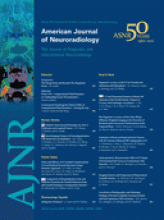Research ArticleSpine Imaging and Spine Image-Guided InterventionsC
CT Myelography for the Planning and Guidance of Targeted Epidural Blood Patches in Patients with Persistent Spinal CSF Leakage
C.M. Wendl, F. Schambach, C. Zimmer and A. Förschler
American Journal of Neuroradiology March 2012, 33 (3) 541-544; DOI: https://doi.org/10.3174/ajnr.A2808
C.M. Wendl
F. Schambach
C. Zimmer

References
- 1.↵
- Schievink WI,
- Reimer R,
- Folger WN
- 2.↵
- Paldino M,
- Mogilner AY,
- Tenner MS
- 3.↵
- Ferrante E,
- Arpino I,
- Citterio A
- 4.↵
- 5.↵
- Franzini A,
- Messina G,
- Nazzi V,
- et al
- 6.↵
- 7.↵
- Berroir S,
- Loisel B,
- Ducros A,
- et al
- 8.↵
- 9.↵
- Schievink WI
- 10.↵
- Kroin JS,
- Nagalla SK,
- Buvanendran A,
- et al
- 11.↵
- 12.↵
- Kantor D,
- Silberstein SD
- 13.↵
- Rai A,
- Rosen C,
- Carpenter J,
- et al
- 14.↵
- Kranz PG,
- Gray L,
- Turner JN
- 15.↵
- 16.↵
- 17.↵
- Mokri B,
- Posner JB
- 18.↵
- Schievink WI,
- Jacques L
- 19.↵
- Schievink WI,
- Gordon OK,
- Tourje J
- 20.↵
- Mokri B
- 21.↵
- Koss SA,
- Ulmer JL,
- Hacein-Bey L
- 22.↵
- Mokri B,
- Piepgras DG,
- Miller GM
- 23.↵
- Fishman RA,
- Dillon WP
- 24.↵
- Vanopdenbosch LJ,
- Dedeken P,
- Casselman JW,
- et al
- 25.↵
- Albayram S,
- Kilic F,
- Ozer H,
- et al
- 26.↵
- Kapoor R,
- Liu J,
- Devasenapathy A,
- et al
- 27.↵
- Kalina P,
- Craigo P,
- Weingarten T
- 28.↵
- Sudlow C,
- Warlow C
- 29.↵
- 30.↵
- Evron S,
- Sessler D,
- Sadan O,
- et al
In this issue
Advertisement
C.M. Wendl, F. Schambach, C. Zimmer, A. Förschler
CT Myelography for the Planning and Guidance of Targeted Epidural Blood Patches in Patients with Persistent Spinal CSF Leakage
American Journal of Neuroradiology Mar 2012, 33 (3) 541-544; DOI: 10.3174/ajnr.A2808
0 Responses
Jump to section
Related Articles
- No related articles found.
Cited By...
This article has not yet been cited by articles in journals that are participating in Crossref Cited-by Linking.
More in this TOC Section
Similar Articles
Advertisement











